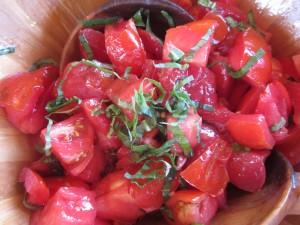
It was almost 100 degrees today. When it gets this hot in the US, Americans disappear into their air conditioned houses and cars, but Italians come out to live on the street, in their gardens, on their terraces, under their neighbors’ noses. All the windows are open to the warm night and the still air is filled with voices of the neighborhood chatting about the days’ events, silverware clinking on plates as the evening meal is shared al fresco. Normally private conversations are open to everyone. Nothing is concealed in the still heat. Clothes come off, people come out and the entire town becomes your living room.
The simplest of meals is served. Tomatoes tossed with fresh basil, olive oil and salt. Sliced salami and cheese. Cold tuna and white beans, maybe a slice of frittata from lunch. Glasses of chilled white wine. Nothing that requires turning on the stove or oven. It’s too hot for heat.
An ice cream is suggested and we walk to the crowded bar to see what might be left in the freezer case.
Summer salad of Tomatoes with Basil
Cut up 3 or 4 very ripe large tomatoes, tear or chiffonade several basil leaves, sprinkle with sea salt and drizzle with great extra virgin olive oil. You can toss in a whole garlic clove and let it flavor the dish for a few minutes if you like. Be sure to serve with some good bread for sopping up the juices.
Tuna and Cannellini Bean salad
Open a can or jar of the best quality tuna you can find and a can of cannellini or white beans. Thinly slice a red onion. Toss the whole thing with some great extra virgin olive oil and sea salt, maybe a few leaves of parsley, and serve.
 I read one of those columns by some food writer about what’s in and what’s out for 2013, and on the list of what’s out was kale. And I thought, how can kale be out when it’s hardly been in?? It’s so good for you and is so abundant right now that we should work a little harder to figure out how we can work it into our diets. We can’t give up so easily and declare it out of fashion so quick.
I read one of those columns by some food writer about what’s in and what’s out for 2013, and on the list of what’s out was kale. And I thought, how can kale be out when it’s hardly been in?? It’s so good for you and is so abundant right now that we should work a little harder to figure out how we can work it into our diets. We can’t give up so easily and declare it out of fashion so quick.











